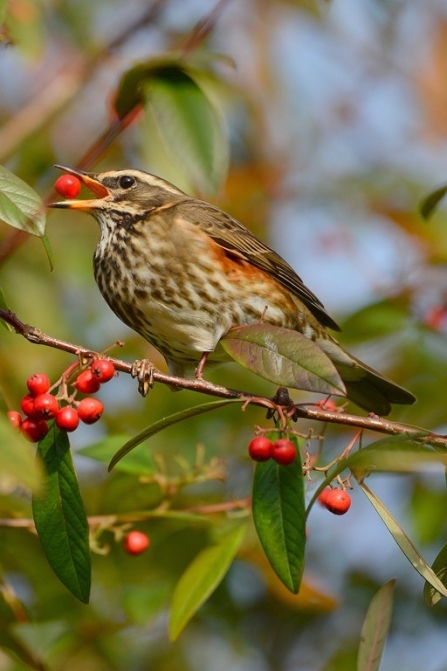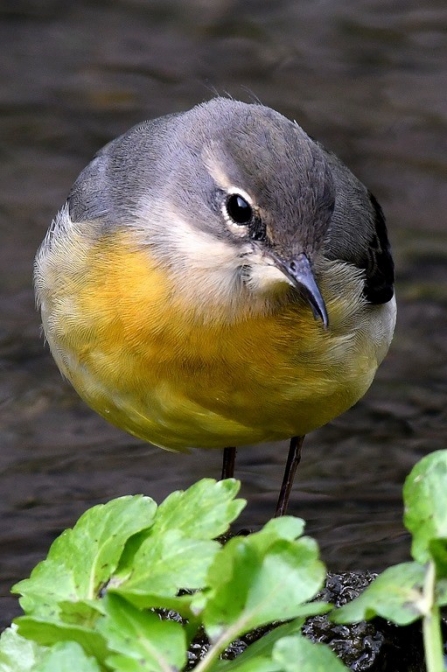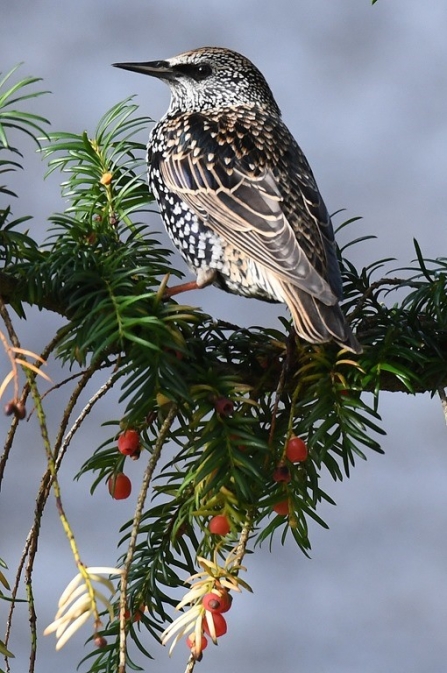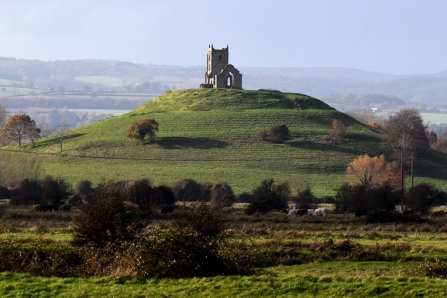Chris Chappell advises the wildlife to watch out for in November...
The change of season brings stunning autumn colours, the Somerset countryside transformed into yellows, orange and brown.
Autumnal mist - David Tipling
The change of season brings stunning autumn colours, the Somerset countryside transformed into yellows, orange and brown.

Goldcrest - Chris Chappell
Our summer visiting birds have now gone, and winter species are arriving.
There is a massive migration from the north and east of many bird species, from tiny goldcrests and firecrests, to corvids and pigeons. Out on the flooded meadows and the levels, winter duck numbers are growing steadily, teal wigeon, gadwall and pintail. They are joined by waders, from the diminutive ringed plovers to curlew and black tailed godwit. Somerset provides vital wintering grounds for many species, the estuarine mudflats on Bridgwater Bay in particular, and the area is now protected as a National Nature Reserve.
The starling murmurations on the levels are growing in size, and a good display can be seen as the birds arrive each evening. The birds head for the levels to roost in the reedbeds from many miles around, smaller flocks merging in vast numbers as they near their destination. If you have never seen this, the spectacle will astonish you, with the sky full of starlings, and the murmur of thousands of wings.

Starling murmurations - Chris Chappell
The unusual patterns in the sky formed by the starlings are usually provoked by the appearance of a predator, the swirling mass o birds making it more difficult to catch an individual bird. And if you can manage an early start, watching the birds leaving the reed-bed roost is a wonderful sight on a sunny morning.

Redwing - Chris Chappell
Cold nights and strong winds have stripped the deciduous trees of leaves, and the bare branches now reveal the characteristic shapes of the various species. The rain and wind has flattened much of the vegetation, as the countryside takes on a winter hues. The bare branches also make bird spotting that much easier.
Winter thrushes, fieldfare and redwing are now settling in, and may be seen gorging themselves on the various berries. And the berries are particularly luxuriant this year. Rose hips, hawthorn, spindle and pyracantha are abundant, plus a heavy crop of yew berries.
Conditions are now good for fungi, and there have been impressive eruptions of the common edible field mushrooms, and the not so welcome honey fungus. Perhaps the most famous fungi, fly agaric, grows well in birch woods and heathland, and will be seen through the autumn until cold weather sets in. Look for the classic red cap with raised white spots.
The further improvements to this reserve, now with two 'scrapes' or open water areas, continues to attract a great variety of birds.
The water level on Catcott Lows is now rising, and the winter ducks are beginning to arrive. Wigeon, teal and shoveler will spend the winter on the levels, and with luck some pintail will also be seen, a special bird, rather more elegant than most ducks. Pintail are bottom feeders, characteristically up-ending with their long tails in the air, while they dabble for nutrients among the vegetable matter and invertebrates below. The male is a striking bird, with white neck extending up to the head in a stripe, while the head is a subtle chocolate, and the beak pale blue. Grey flank, black rump with white between, and patterned black and white wing feathers complete the picture. The female is very understated by comparison, in mottled browns. Sadly, the pintail is still a 'quarry' species, and may be legally shot.

Catcott - Chris Chappell
A very special winter visitor to this area is the hen harrier, already seen this year. This very rare and beautiful raptor is under threat from persecution due to their fondness for grouse chicks on the moors in the north of England. The male is pale grey and white with black wing tips, the female and juvenile form have a white band to the base of the tail, known as 'ringtails' which clearly distinguishes it from our resident marsh harriers. In addition to the cattle egret, little and great white egret can also be seen, along with a number of grey heron. Soon, snipe lapwing and grey plover will join the throng. Roe deer graze at the rear of the reserve, happy to feed in the open if they are sufficiently distant.
While you are at Catcott, it is well worth exploring the small woodland to the east, and the tower hide overlooking some open water. There is an attractive boardwalk through the wood, giving access all year. The woods are good for spotting lesser redpoll, siskin and tree creeper, and more roe deer may be seen skulking among the trees.
At this time of year pied wagtails move in to our towns and villages, where they will feed on roof tops, looking for spiders, seeds and insect larvae. They are vocal birds, calling repeatedly as they flit around the rooftops. They frequently form large roosts in major cities, gathering in noisy flocks. Pied wagtails may also roost in the levels reedbeds, arriving just before dusk.

Grey wagtail - Chris Chappell
The grey wagtail is sometimes confused with the yellow wagtail, as the underparts are largely yellow. However, the yellow wagtails head south in autumn, and overwinter in Africa, so are currently absent. The grey wagtail likes fast running water, but can be found on almost any small stream, feeding on insects and their larvae. They will only be found near water, where they like to land on a prominent rock or tuft of grass midstream. Grey wagtails have the longest tail of the wagtails, and it is a striking bird, the yellows, grey, black and white a delight to see, but actually well camouflaged when feeding on a rippling stream. They are relatively rare, and as such are red listed in conservation terms.
The Polden Hills are comprised of a ten mile ridge running from the village of Street westwards toward Bawdrip. Almost parallel to the Mendips to the north, and the levels to the south, this is an interesting area to explore, and provides great opportunities for a good winters walk. The Polden Ridge originally carried a Roman road running all the way from the fort at Ilchester to the coast at Combwich, and is an area steeped in history.

Starling - Chris Chappell
The SWT has three reserves on the Poldens, Breach Woods, New Hill and Tannager, and Dundon Fort. On a fine day the Polden Hills provide a lovely place for a winter walk. SWT reserves New Hill and Tannager, plus Great Breach Wood can all be explored in a day. In addition, the National Trust own adjoining land at Collard Hill and Walton Hill to the west. The area offers mature trees, where you may find nuthatches and woodpeckers, and also open areas where buzzards will soar overhead, or you may hear the deep croak of the raven. Kestrels hunt for voles and mice, identifiable as the only falcon that will hover for any length of time. The kestrel's ability to hold a position on a blustery day, while they scan the ground for prey is a wonder to watch.
The noisy cackle of the green woodpecker, or yaffle, rings through the oak woods. The yaffle likes to feed on ants, of which there is a good supply on the Polden ridge. There are fabulous views from the Poldens across Kings Sedgemoor to the south, showing the Somerset countryside in all its autumn glory. Ancient hawthorn bushes are heavy with berries, and old man's beard looks its very best, sprawling over the landscape with the silver seed heads sparkling in the sun.

Burrow Mump - Chris Chappell